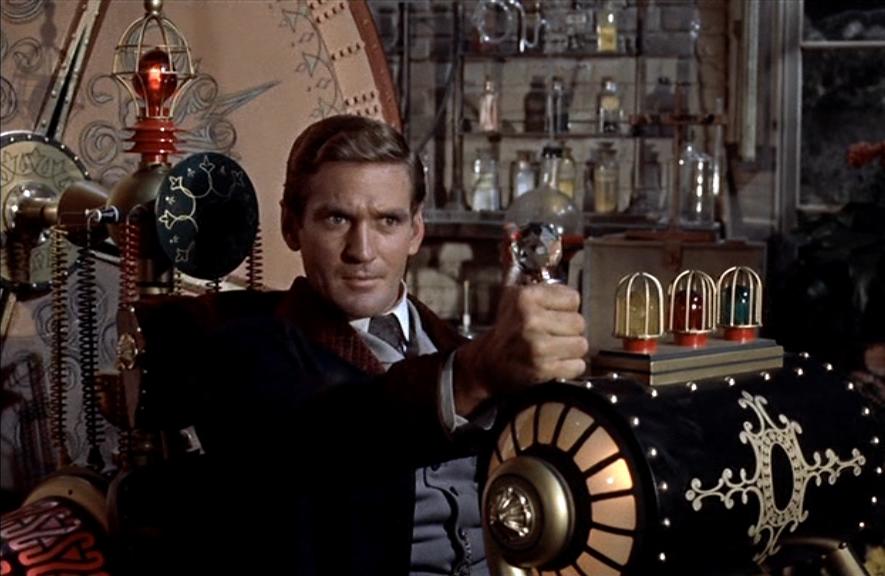The Time Machine

George Pal
USA – 1960

Screenplay: David Duncan
Cinematography: Paul Vogel
Production: George Pal Productions Galaxy Films Inc.
Language: English
Duration: 103 min
Color: Color
Synopsis: Arriving late and disheveled to his own dinner party, a scientist informs his friends of his recent tests involving the Time Machine, an invention of which they remain skeptical as they do not see any practical use for the device even if it works. His findings reveal that, although the machine may be stationary in space, changes to the location over time may affect travel. Neither pilot nor device are immune to the elements, or to the intentions of others. The scientist tells his friends that the Utopian society of the future that he longed to find does not exist. Instead, human civilization several thousand years into the future consists of the maleficent subterranean morlocks and the infantile surface dwelling eloi. At a first glance, the eloi lead a carefree life, but he soon finds out that there is a sinister design behind their welfare. However, the scientist also discovers that love is one element that can remain unchanged by time and can bloom over the spread of millennia.
Notes:
Because cinema itself has the properties of a time machine, it lends itself easily to time travel stories, one of the staples of science fiction literature. George Pal was drawn to Wells’ story in part because it provided opportunities for state-of-the-art visual effects. His film version of The Time Machine uses many time-domain techniques including accelerated motion, reverse motion, as well as pixellation, model shots and mattes to render the experience of time travel, and the future worlds the Traveller encounters, with as much verisimilitude as was possible in the 1960s. Pal was a specialist in technologies of illusion. He began his career as a puppeteer making short advertising films in the late 1930s. In the 1940s he went to Hollywood and moved on to adventure films where he specialized in trick effects, receiving an Academy Award in 1943 for his development of innovative methods and techniques. These included Destination Moon (Irving Pichel, 1950), When Worlds Collide (Rudolph Maté, 1951), War of the Worlds, Tom Thumb (1958, which he also directed) and The Time Machine. All of these films won Oscars for their special effects. Pal’s special skill, then, was to realize the incredible, to make the alien and strange comprehensible according to visual conventions we can accept. Pal’s version of The Time Machine was so exquisite (it made MGM take an interest in science fiction) that we may even excuse the film’s concealment of H.G. Wells’ bizarre class analysis of the eloi and the morlocks, which, ultimately, was the point of the original story.
Hollywood filmmakers of the 1950s and early 60s did far more than simply broadcast Cold War fears. Just a few years removed from Hiroshima and Nagasaki, Atomic bombs or fallout figure prominently. They did not speak with one voice, and often sent clashing messages within the same film. Entertainment and profit-making were doubtless their first priorities, yet together they signaled turbulence in a decade normally imagined as prelude to the really turbulent one that followed it. This sense of destabilization, anxiety, and confusion so pervaded American life that screenwriters could expect knowing chuckles at references to it. In the 1953 film The Beast from 20,000 Fathoms, scientist Tom Nesbitt, convalescing after a harrowing experience in the Arctic, asks a nurse, “What’s going on in our turbulent world today?” “Oh, death and politics,” she responds. “The comic page is the only thing that makes sense anymore.” Indeed, the cluster of 1950s films on futuristic space travel and alien invasion introduced audiences to all manner of weird machines, robots, weapons, and other phenomena, of human and alien origin, meant, in part, to represent nuclear arms. The Time Machine (1960) reveals the damage wrought by a future nuclear war. The Beast from 20,000 Fathoms (1953) pictures a prehistoric monster revived by an atomic detonation in the Arctic, and radiation enlarges and enrages an army of ants in Them! (1954).
Excerpts drawn and adapted from Huebner, Andrew J. “Lost in space: technology and turbulence in futuristic cinema of the 1950s.” Film & History no. 2 (2010): 6. and Bignell, Jonathan. “Another time, another space: modernity, subjectivity and The Time Machine.” Liquid Metal: The Science Fiction Film Reader (2009): 136-43.


